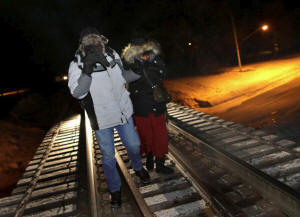|
Door knocks in the dark: The Canadian
town on front line of Trump migrant crackdown
 Send a link to a friend
Send a link to a friend
 [February 28, 2017]
By Rod Nickel [February 28, 2017]
By Rod Nickel
EMERSON, Manitoba (Reuters) - Jaime French
was jarred out of bed in Emerson, Manitoba early one morning this month
by pounding at her front door, just yards from the U.S. border. A face
peered in through the window, flanked in the darkness by others.
Outside were 16 asylum seekers, arriving at one of the first houses they
saw after crossing a lightly monitored border between Canada and the
United States.
"They banged pretty hard, then 'ring ring ring' the doorbell," said
French, a mother of two young girls. "It was scary. That really woke me
up."
The town has become the front line of an emerging political crisis that
is testing Canada's will to welcome asylum seekers.
Hundreds of people, mainly from Africa but also the Middle East, are
fleeing U.S. President Donald Trump's crackdown on illegal immigrants,
migrants and refugee agencies say. Many asylum seekers say Trump's
election and subsequent crackdown on illegal migrants spurred their
plans to head north.
Those arriving in Emerson come on foot in the dead of night, unnerving
its 650 residents. Some fear the influx of unscreened migrants while
others are frustrated by the cost and effort forced on the community.

Prime Minister Justin Trudeau is under increased pressure from the left,
which wants him to let more in, and from the right, which is fearful of
an increased security risk. Trudeau must tread carefully to ensure the
issue does not complicate relations with Trump.
The cooling welcome in Emerson is a microcosm of growing discontent over
Canada’s open door policy for refugees.
Last week, an Angus Reid poll found that while 47 percent of respondents
said Canada is taking in the right number of refugees, 41 percent said
the number is already too high. (See the report)
(http://angusreid.org/syrian-refugee-travel-ban/)
"It could become a real political liability for the government," said
Christian Leuprecht, a politics professor at the Royal Military College
of Canada, noting that spring will lead to more crossings as travel gets
easier.
THAWING OUT IN THE KITCHEN
After the 16 migrants left French's home, without being admitted, they
found truck driver Brad Renout two doors down leaving for work.
"I was going to leave them all outside," Renout said. "I figured, to
hell with (them) for coming over the border in winter."
When he saw children among the group, Renout allowed three women, three
toddlers and two teenagers into his kitchen.
Early Sunday, Reuters witnessed at least seven migrants bundled in new
parkas and bulging backpacks walking into Canada from Minnesota,
following railway tracks in the icy dark.
Ismail, a 25-year-old Somali man, said they had walked for 22 hours
without sleep across North Dakota. As police lights flashed distantly,
Ismail said he was afraid to walk toward them.
He thought the group was still on U.S. soil.
Canadian police caught up with them shortly afterward and arrested them
for illegally entering Canada. The group squeezed, uncuffed, into a
police minivan and headed to a government office for questioning.

"We feel sorry for the people," said retired grain farmer Ken Schwark.
"I just wish they would come through the legal way."
A 2004 agreement between Canada and the United States means asylum
seekers must submit applications in the United States if they arrive
there first. But if they find a way into Canada, they can apply for
refugee status there.
It's an avenue that has spurred north illegal migrants in the United
States, especially Somalis settled in Minnesota, which shares a land
border with Manitoba. After pricey taxi rides to North Dakota, many like
Ismail walk for hours in darkness and -20 C (-4°F) temperatures to dimly
lit Emerson, in the shadow of the bright glare of the international
border crossing.
The lucky migrants get rides dropping them off less than a mile from
Noyes, Minnesota, within sight of Emerson's southern edge. From there
they duck under a metal crossing-arm gate, walk across the border and
often use their own cellphones to dial police.
[to top of second column] |

Refugees walk along railway tracks from the United States to enter
Canada at Emerson, Manitoba, Canada, February 26, 2017. REUTERS/Lyle
Stafford

Others are dropped 30 or more kilometers (19 miles) from the border,
and follow rail lines into Emerson, crossing a border marked in most
areas only by scattered concrete boundary markers.
Faye Suderman, a four-decade Emerson resident, said she is
sympathetic but draws a line between those fleeing persecution and
those who have simply run out of chances in the United States: "How
difficult is it to get rid of those people and give help to those
truly in need?"
Emerson Cafe manager Jacquelyn Reimer, who has fed shivering asylum
seekers for free, wondered why the Canadian government is helping
refugees when the country has its own homeless problem. "We can't
even take care of our own," she said.
MAKESHIFT BEDS, NUTELLA SANDWICHES
Due to its border-hugging location, Emerson's encounters with
migrants are not new, but the scale of their arrivals is.
In the first two months of 2017, 143 mainly Somali people walked
illegally over the border into Emerson, representing 40 percent of
Manitoba's full-year total in 2015/16. Quebec and British Columbia
are the two other major illegal crossing points, but police there
refused to provide data.
Emerson residents don’t encounter the migrants for long before
police arrive and whisk them to the local Canada Border Services
Agency (CBSA) office for questioning. From there, they are ferried
to Winnipeg, Manitoba's capital, to file asylum claims.
Despite some residents’ fears, asylum-seekers have not caused any
trouble, said Bill Spanjer, Emerson's emergency coordinator.

"They're going to be on their best behavior because otherwise their
refugee claim is certainly going to be affected," he said.
When police receive a call, they summon the town's volunteer
firefighters to treat any health concerns, as the nearest ambulance
is 25 minutes away. In December, two men from Ghana lost all of
their fingers to frostbite.
Firefighter callouts cost Emerson about C$500 each time. The costs
may add up to C$30,000 since last spring, representing 10 percent of
its firefighting budget, said Emerson-Franklin's elected leader Greg
Janzen. The provincial government directed more resources to Emerson
last week, including paramedics and paralegal and transportation
services.
Since the influx sped up in January, the strain on Emerson has
grown. In early February, police intercepted 18 migrants from
Somalia and Djibouti and CBSA asked Emerson to temporarily house
them in the town's ice rink.
Brenda Piett and other volunteers laid folding banquet tables on the
concrete floor, and layered them with blankets for makeshift
mattresses. At the migrants’ request, they served white bread
sandwiches with Nutella hazelnut spread.
"The groups are getting bigger, and the stories are scary, how far
they’ve walked," said Piett, an inventory clerk at Emerson's
duty-free store. "But it does affect our town. Some people are very
scared of it."
(Additional reporting by David Ljunggren in Ottawa and Allison
Lampert in Montreal; Editing by Amran Abocar and Ross Colvin)
[© 2017 Thomson Reuters. All rights
reserved.]
Copyright 2017 Reuters. All rights reserved. This material may not be published,
broadcast, rewritten or redistributed.
 |